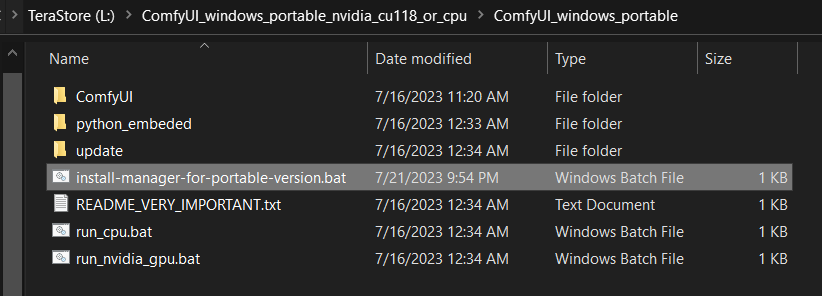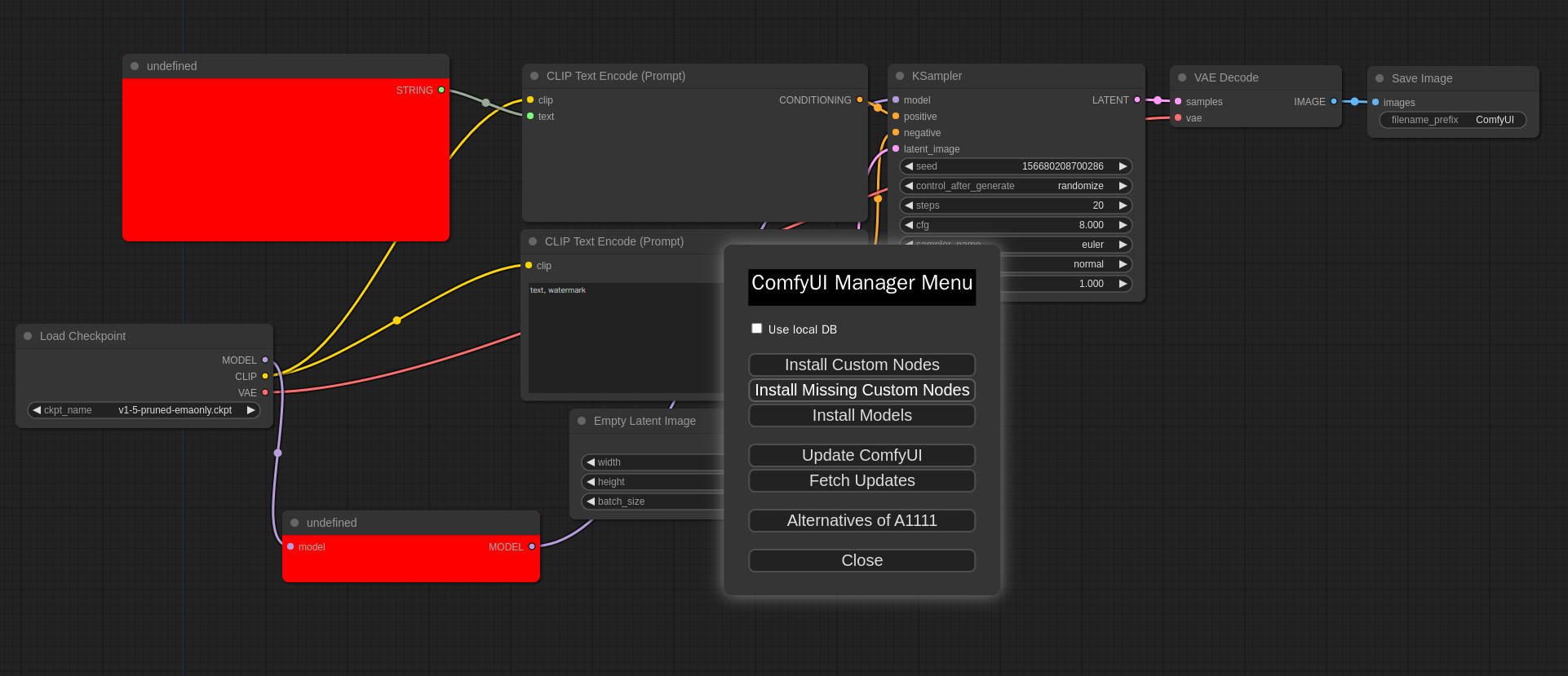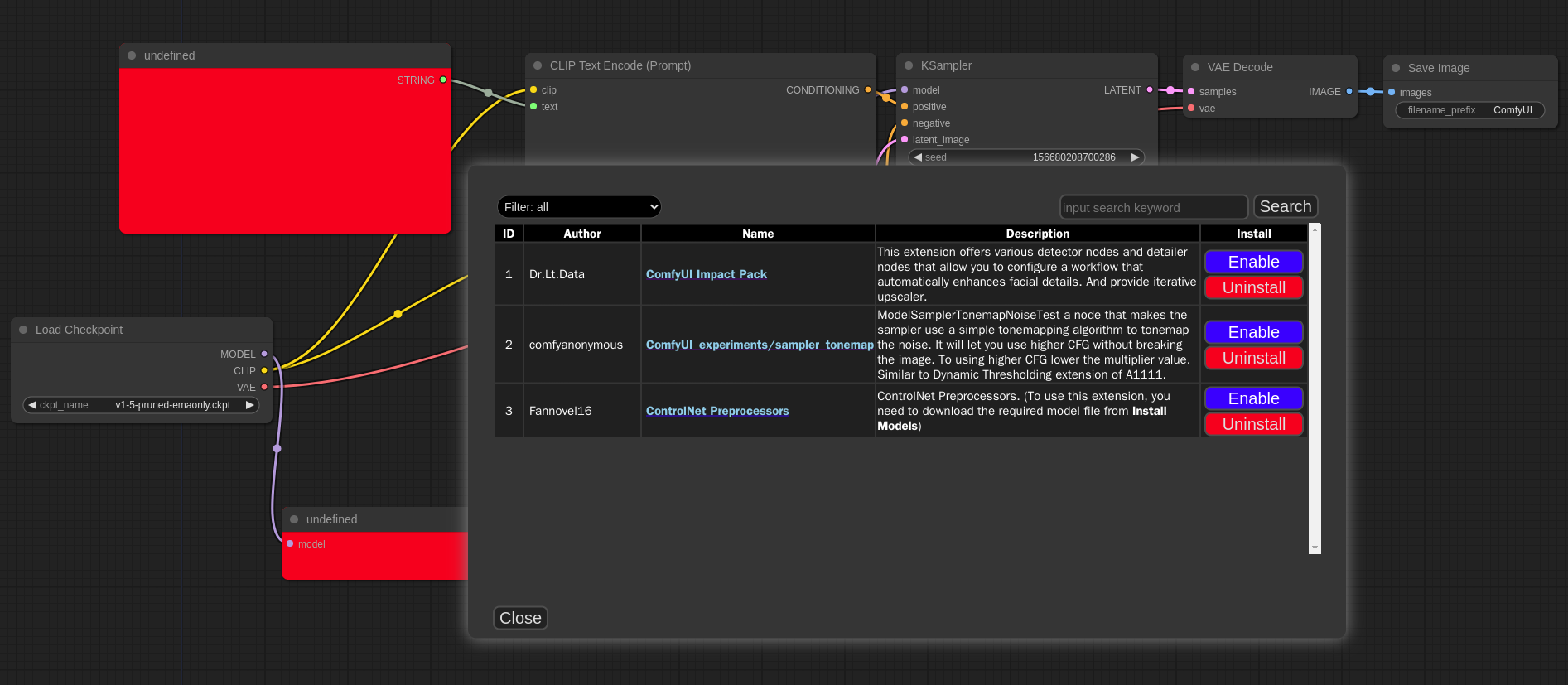|
|
1 year ago | |
|---|---|---|
| js | 1 year ago | |
| misc | 1 year ago | |
| notebooks | 1 year ago | |
| scripts | 1 year ago | |
| .gitignore | 1 year ago | |
| LICENSE.txt | 1 year ago | |
| README.md | 1 year ago | |
| __init__.py | 1 year ago | |
| alter-list.json | 1 year ago | |
| custom-node-list.json | 1 year ago | |
| extension-node-map.json | 1 year ago | |
| git_helper.py | 1 year ago | |
| model-list.json | 1 year ago | |
| prestartup_script.py | 1 year ago | |
| requirements.txt | 2 years ago | |
| scan.sh | 1 year ago | |
| scanner.py | 1 year ago | |
README.md
ComfyUI Manager
Installation[method1] (General installation method: ComfyUI-Manager only)
To install ComfyUI-Manager in addition to an existing installation of ComfyUI, you can follow the following steps:
- cd custom_nodes
- git clone https://github.com/ltdrdata/ComfyUI-Manager.git
- Restart ComfyUI
Installation[method2] (Installation for portable ComfyUI version: ComfyUI-Manager only)
- Download scripts/install-manager-for-portable-version.bat into installed
"ComfyUI_windows_portable"directory - double click
install-manager-for-portable-version.batbatch file
Installation[method3] (Installation for linux+venv: ComfyUI + ComfyUI-Manager)
To install ComfyUI with ComfyUI-Manager on Linux using a venv environment, you can follow these steps:
- Download scripts/install-comfyui-venv-linux.sh into empty install directory
- ComfyUI will be installed in the subdirectory of the specified directory, and the directory will contain the generated executable script.
chmod +x install-comfyui-venv-linux.sh./install-comfyui-venv-linux.sh
You can execute ComfyUI by running either ./run_gpu.sh or ./run_cpu.sh depending on your system configuration.
Changes
- 0.13 Support additional 'pip' section for install spec
- 0.12 Better installation support for Windows.
- 0.9 Support keyword search in installer menu.
- V0.7.1 Bug fix for the issue where updates were not being applied on Windows.
- For those who have been using versions 0.6, please perform a manual git pull in the custom_nodes/ComfyUI-Manager directory.
- V0.7 To address the issue of a slow list refresh, separate the fetch update and update check processes.
- V0.6 Support extension installation for missing nodes.
- V0.5 Removed external git program dependencies.
How To Use
- Click "Manager" button on main menu
-
When the 'Use local DB' feature is enabled, the application will utilize the data stored locally on your device, rather than retrieving node/model information over the internet
-
The
Fetch Updatesmenu retrieves update data for custom nodes locally. Actual updates are applied by clicking theUpdatebutton in theInstall Custom Nodesmenu.
- Click 'Install' or 'Try Install' button.
- Installed: This item is already installed.
- Install: Clicking this button will install the item.
- Try Install: This is a custom node of which installation information cannot be confirmed. Click the button to try installing it.
Custom node support guide
-
Currently, the system operates by cloning the git repository and sequentially installing the dependencies listed in requirements.txt using pip, followed by invoking the install.py script. In the future, we plan to discuss and determine the specifications for supporting custom nodes.
-
Please submit a pull request to update either the custom-node-list.json or model-list.json file.
-
The scanner currently provides a detection function for missing nodes, which is capable of detecting nodes described by the following two patterns.
- Or you can provide manually
node_list.jsfile.
- Or you can provide manually
NODE_CLASS_MAPPINGS = {
"ExecutionSwitch": ExecutionSwitch,
"ExecutionBlocker": ExecutionBlocker,
...
}
NODE_CLASS_MAPPINGS.update({
"UniFormer-SemSegPreprocessor": Uniformer_SemSegPreprocessor,
"SemSegPreprocessor": Uniformer_SemSegPreprocessor,
})
- Special purpose files (optional)
node_list.js- When your custom nodes pattern of NODE_CLASS_MAPPINGS is not conventional, it is used to manually provide a list of nodes for reference. (example)requirements.txt- When installing, this pip requirements will be installed automaticallyinstall.py- When installing, it is automatically calleduninstall.py- When uninstalling, it is automatically calleddisable.py- When disabled, it is automatically called- When installing a custom node setup
.jsfile, it is recommended to write this script for disabling.
- When installing a custom node setup
enable.py- When enabled, it is automatically called
Support of missing nodes installation
- When you click on the
Install Missing Custom Nodesbutton in the menu, it displays a list of extension nodes that contain nodes not currently present in the workflow.
-
Currently, support is not available for custom nodes that can only be downloaded through civitai.
Troubleshooting
- If Controlnet is set to skip_v1 true, nodes like
CannyEdgePreprocessorwill appear as extensions of missing nodes, but simply installing them is not enough, and direct modification of the user's config.yaml is required. - For cases where nodes like
PreviewTextNodefromComfyUI_Custom_Nodes_AlekPetare only supported as front-end nodes, we currently do not provide missing nodes for them.
TODO: Unconventional form of custom node list
- https://github.com/bmad4ever/ComfyUI-Bmad-Custom-Nodes
- https://github.com/diontimmer/Sample-Diffusion-ComfyUI-Extension
- https://github.com/laksjdjf/pfg-ComfyUI
Roadmap
- category/keyword filter
- Automatic recognition of missing custom nodes
- Automatic installation suggestion of missing custom nodes
- installation from git url
- 3rd party repository
- Specification of custom nodes
- Specification scanner
- Search extension by node name
- workflow downloader
Disclaimer
- This extension simply provides the convenience of installing custom nodes and does not guarantee their proper functioning.






